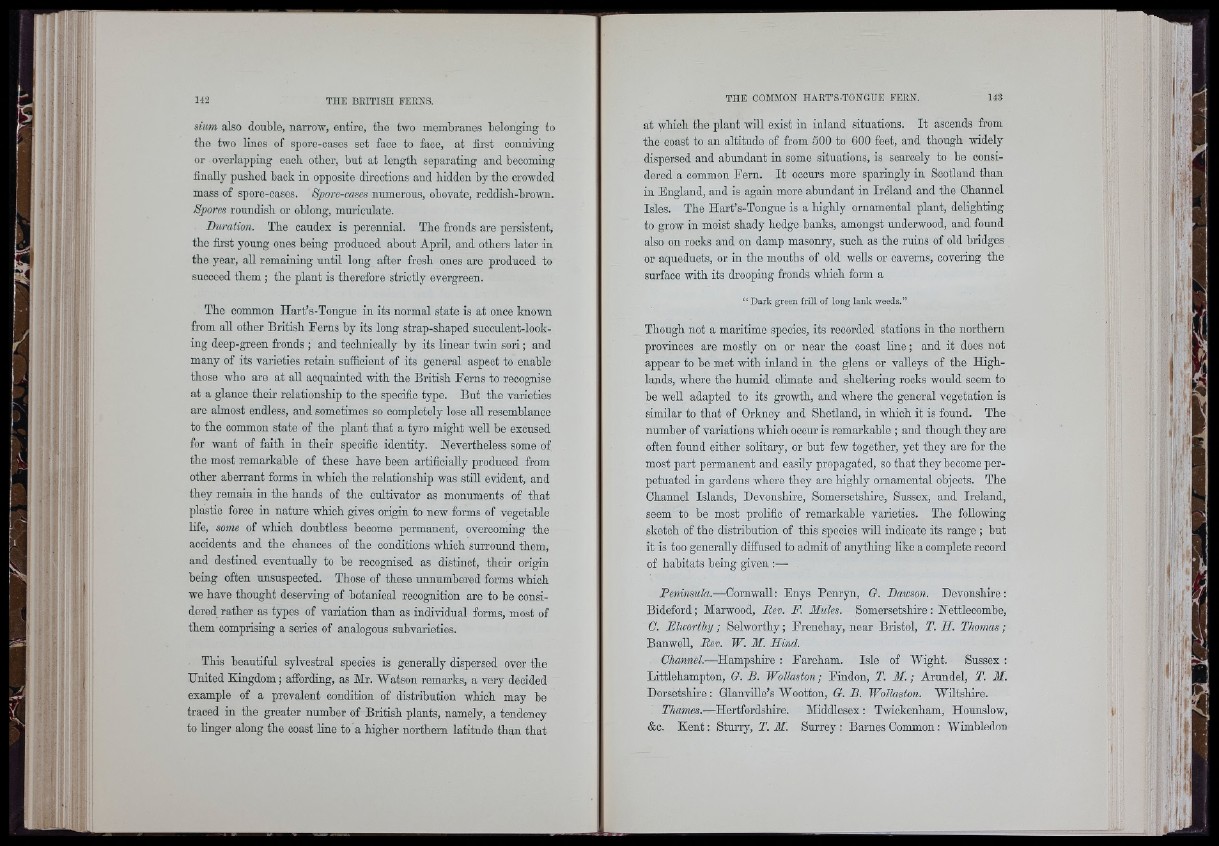
■■TíUÍ
siimi also double, narrow, entire, the two membranes belonging to
the two lines of spore-cases set face to face, at first conniving
or overlapping each other, but at length separating and becoming
finally pushed back in opposite directions and hidden by the crowded
mass of spore-cases. Spore-cases numerous, obovate, rcddish-browu.
Spores roundish or oblong, muriculate.
JDiiraiion. The caudex is perennial. Tho fronds are persistent,
tho first young ones being produced about April, and others later in
tho year, all remaining until long after fresh ones are produced to
succeed them ; the plant is therefore strictly evergreen.
The common Hart’s-Tongue in its normal state is at once known
from all other British Ferns by its long strap-shaped succulent-looking
deep-green fronds ; and technically by its linear twin sori; and
many of its varieties retain sufficient of its general aspect to enable
those who are at all acquainted with the British Ferns to recognise
at a glance their relationship to the specific type. But the varieties
are almost endless, and sometimes so completely lose all resemblance
to the common state of the plant that a tyro might well he excused
for want of faith in their specific identity. Nevertheless some of
tho most remarkable of these have been artificially produced from
otber aberrant forms in which the relationship was still evident, and
they remain in the hands of the cultivator as monuments of that
plastic force in nature which gives origin to new forms of vegetable
life, some of which doubtless become permanent, overcoming tho
accidents and the chances of the conditions which surround them,
and destined eventually to he recognised as distinct, thoir origin
being often unsuspected. Those of these unnumbered forms which
we have thought deserving of botanioal recognition arc to be considered
rather as types of variation than as individual forms, most of
them comprising a series of analogous subvarieties.
This beautiful sylvestral species is generally dispersed over the
United Kingdom; affording, as Mr. Watson remarks, a very decided
example of a prevalent condition of distribution which may be
traced in the greater number of British plants, namely, a tendency
to Hnger along the coast hne to a higher northern latitude than that
at which tho plant will exist in inland situations. It ascends from
the coast to an altitude of from 500 to 600 foet, and though widely
dispersed and abundant in some situations, is scarcely to he considered
a common Fern. It occurs moro sparingly in Scotland than
in England, and is again more abundant in Ireland and tbe Channel
Isles. The Hart’s-Tongue is a highly ornamental plant, delighting
to grow in moist shady hedge banks, amongst underwood, and found
also on rocks and on damp masonry, snob as the ruins of old bridges
or aqueducts, or. in the mouths of old weUs or caverns, covering the
surface with its drooping fronds which form a
“ Dark green frill of long la n k weeds.”
Though not a maritime species, its recorded stations in the northern
provinces are mostly on or near the coast lin e ; and it does not
appear to be met with inland in the glens or valleys of the Highlands,
where the humid climate and sheltering rooks would seem to
be well adapted to its growth, and where the general vegetation is
similar to that of Orkney and Shetland, in which it is found. The
number of variations which occur is remarkable ; and though they are
often found either solitary, or but few together, yet they are for the
most part permanent and easily propagated, so that they become perpetuated
in gardens where they are highly ornamental objects. The
Channel Islands, Devonshire, Somersetshire, Sussex, and Ireland,
seem to he most prolific of remarkable varieties. The following
sketch of the distribution of this species will indicate its range ; but
it is too generally diffused to admit of anything hke a complete record
of habitats being given :—
Peninsula.—Cornwall: Enys Penryn, G. Bawson. Devonshire:
Bideford; Marwood, Rev. F. Mules. Somersetshire: Nettlecombe,
O. Elworthy; Selwortby; Frenchay, near Bristol, T. II. Thomas;
Ban well. Rev. W. M. Sind.
Channel.—Hampshire : Faroham. Isle of Wight. Sussex :
Littlehampton, G. B. Wollaston; Findon, T. M .; Arundel, T. M.
Dorsetshire : Glanville’s Wootton, G. B. Wollaston. Wiltshire.
Thames.—Hertfordshire. Middlesex: Twickenham, Hounslow,
&o. Kent: Sturry, T. M. Surrey : Barnes Common: WimbledoTi
' ; k
.,.
D VPi
1 i. . I
(!E ‘! V~ I